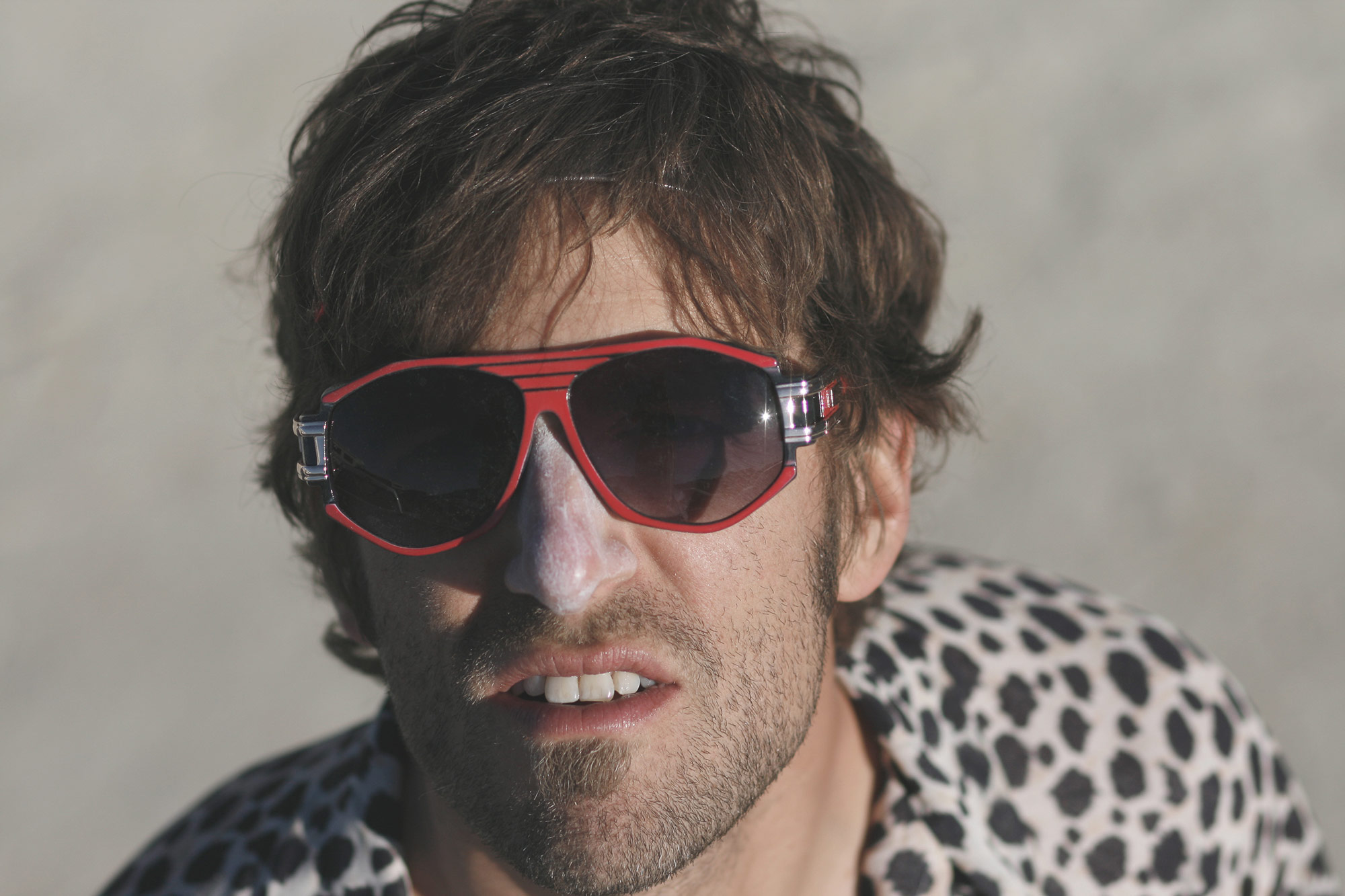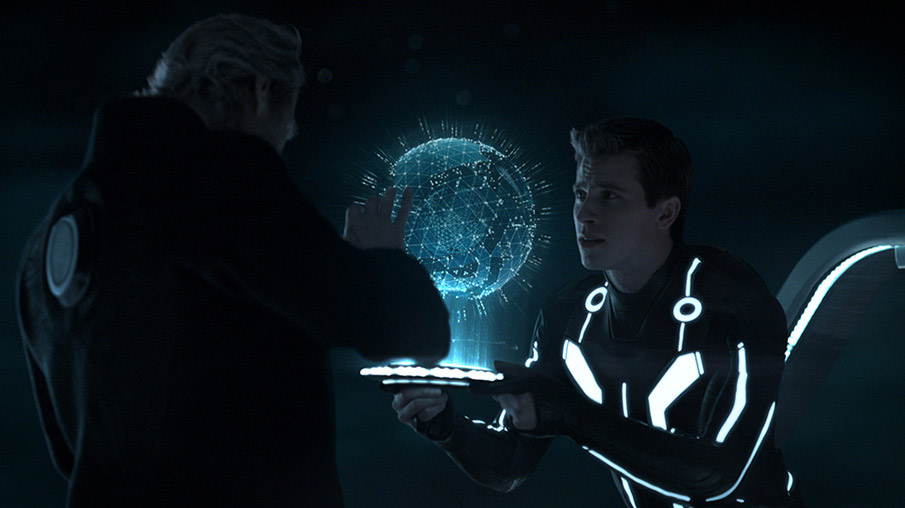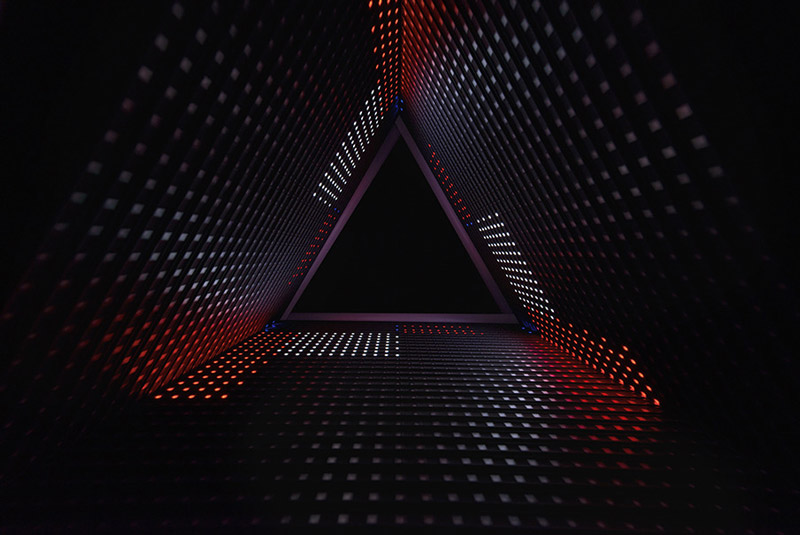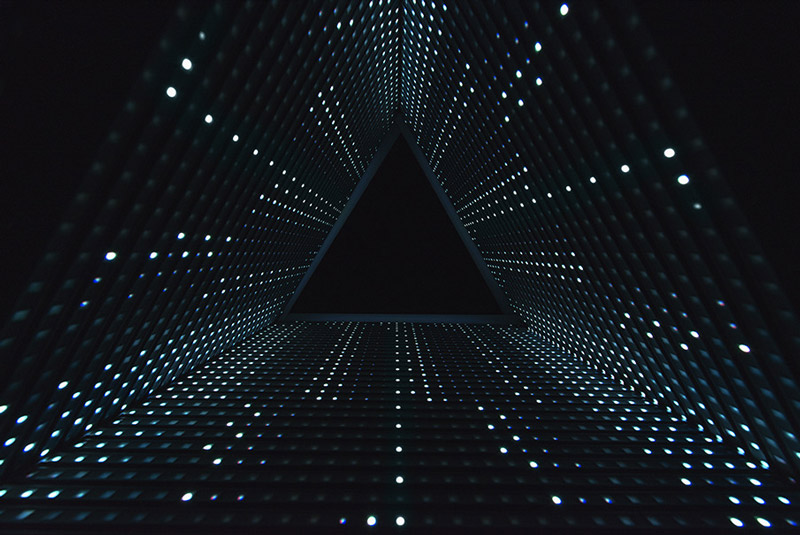
- Interview by Ryan & Tina Essmaker November 26, 2013
- Photo by Jesse Golden
GMUNK
- artist
- designer
Bradley G Munkowitz, aka GMUNK, is a graphic designer with over a decade of experience in the motion graphics industry. He is passionately involved in the global design community, giving lectures around the world. He designed UI and holographic sequences for the feature films Tron: Legacy and Oblivion and has collaborated with distinguished international brands via his work at Buck, Prologue Films, Transistor Studios, and Bot & Dolly.
Interview
What was your path to doing what you’re doing now?
I grew up playing hardcore Dungeons and Dragons—not video games, but role-playing games—and I was always big into fantasy and wanted to make films. In high school, I did stop-motion films with work I made in ceramics class. I ended up studying filmmaking and graphic design at Humboldt State, even though I started out as an oceanography major as I loved the water and exploring beneath its surface. In Arcata, CA, where I went to school, there was this big research vessel, and I had taken a few trips on it. We went out in the freezing cold to collect sediments in the mud and analyze shellfish reproduction cycles—studying oceanography wasn’t what I had expected.
However, I really loved making the charts to analyze the data. I’d spend five hours making beautiful, intricate charts by hand and ten minutes analyzing the data. My oceanography teacher said, “Hey, you should really take a graphic design class, because this isn’t normal. No scientist gives a shit about what the charts look like.” So I took a design class. I decided to take film classes as well and made a double major out of studying design and film.
Between 1995 and 2000, I got really into Flash, which was the new thing. I started fucking around and taught myself how to use it while I was in college. During my senior year, I entered a Flash competition called The New Media Invision Awards, and I won best of show. I went to San Francisco for the awards ceremony, and that’s where I met the two creative directors of Vir2L, which was an interactive company during the dot-com boom. They were super well-funded, hired my ass, and shipped me off to London to work with this dream team of designers: Mike Young, Anders Schroder, James Widegren, Erik Jarlsson, Patrick Sundqvuist, Tom Muller, Philipp Körber—all these hot shit, young graphic design kids from Europe. I was the only American kid in a studio of 20 people, and I was straight out of the woods as this Humboldt hippie-kid transplanted to London. And that’s where I really learned graphic design.
I worked at Vir2L for a year and a half. It was the most inspired time in my career and I was a wild man filled with passion for the craft. The group of us kind of became Internet celebrities because it was so new and people were appreciating all of these Flash websites we did. That’s when I built the seed GMUNK site and started to get traction.
Then, in 2001, we all got laid off as the dot-com bubble burst. I moved to New York and worked for Heavy; then I moved to LA and worked for Imaginary Forces; then I moved to Sydney and worked for Engine Design; and then, from 2004 to 2013, I moved back to LA to work for everybody. In February 2013, I decided to move to San Francisco, and now I freelance at Bot & Dolly and Autofuss, which are these visionary design and robotics companies—it’s very fun.
To be honest, I feel like I’m starting over again now. I have the design foundation, but here in SF, all people talk about is new tech: projection mapping, wild installation shit with robots, motion controlled cinematography, visualizing social networks, and the future of software interfaces. I’m the design director here and it’s like a new beginning; it’s not really motion graphics anymore, which is what I spent most of my time in LA doing. So, yeah, that’s the ride and why I’m feeling fresh with a new palette.
Continuing to keep a personality and fun web presence online has been important to me over the years. Right now on gmunk.com is MUNKsturbate, and I love that thing. I’m trying to figure out what to do next on the site, and I have this idea for a tricked-out breakdancer, but it’s not perverted, so I’m trying to figure out how to make it perverted (laughing)—that’s important.
Okay, that was one hell of a rant. Next question?
Was creativity part of your childhood?
Oh, yeah. I had an older brother and, growing up, we were both big into fantasy. We’d make weapons to play Dungeons and Dragons and imagine these fantastic scenarios. I was also big into superheroes, like most kids.
Then, when I was 10, my parents divorced. My mom moved out and went to live with the Native American tribes in South Dakota, where she stayed for years. I visited her on the reservation and observed the Native American culture, which I didn’t fully appreciate at the time because I was 12. But I certainly took note of their intense spirituality and that made a huge impression on me, even though I didn’t realize it until I looked back on it as an adult.
At home, it was my dad, my older brother, a male housekeeper, a giant male Akita, and me. It was very male-centric and I was this art kid. There were no rules; there was no female figure to tell me to wash my hands or brush my teeth or keep tidy and appropriate—or basically anything like that. So I think that kind of set the stage for a very fearless existence in a lot of ways.
“The two mottos of how I work are: the next project you do has to be your best project, and give it lots of love. Do the work because you want to.”
Did you have an “aha” moment when you knew what you wanted to do?
I think my “aha” moment was getting out of school and going to that first gig in London and seeing a team of Danes, Swedes, Germans, Brits, and others who were just amazingly talented. I came from a small town of 7,000 people, where all the hot shit kids made were posters for “Reggae on the River.” In London, it was high-fashion and high-end design; I was so taken by the talent. I lived and breathed that shit. That first year, I was sleeping on the floor in the office building, creating non-stop because I was so electrified by all the talent and the culture around me. Going from Humboldt County to London was a big culture shock, and it was intense.
Another moment was working with Kosinski on Tron: Legacy and watching him and Eric Barba break down their shots every day at dailies. That was the top level of design, aesthetic, skill, and attention to detail. It was so incredible and I learned so much just watching them work.
I think the third “aha” moment was walking into Bot & Dolly, seeing all these giant robots, and watching them move for the first time. I was like, “Holy shit! Those are mechanized super-beasts!” It’s incredible being there because there’s something different going on every day and, believe me, it’s like an adventure. One day we’re playing with robots manipulating water and sound; another day we’re playing with projections; another day it’s Sharpies and disco balls. It’s definitely enough variety to keep me interested.
Have you had any mentors along the way?
I think that, indirectly, all the guys I worked with at Vir2L were mentors. They weren’t older than me or taking me under their wing in the classic sense, but they were like my college instructors in a lot of ways. We were all very inspired by The Designer’s Republic and The Attik—those were the two big entities whose vibe and aesthetic we sought to bring to the web. I was also really inspired by the work of Chris Cunningham, who I just met face to face a few months ago—such an honor.
Another was Kyle Cooper, who I worked for at Imaginary Forces. He was my first motion graphics mentor. A lot of people have issues communicating with Kyle as he can be intimidating, but I got along with him really well; there was definitely a mutual respect there.
Ryan Honey, the creative director and partner at Buck was a pretty big mentor for me while I was at Heavy and at Buck. He just has such a chill and controlled vibe while carrying so much weight on his shoulders; it’s very impressive. And watching Kosinski and Eric Barba work together was a really educational experience—I can’t stress that enough.
Now I’m supposed to be mentoring others. (laughing) I lead in a variety of ways, but most are kind of subtle. I don’t really have an ego or need the authority or vindication; I kind of mentor others by watching over them, talking to them, and keeping a vibe of cultivation that encourages people and helps make their work better. I find that trusting my artists and believing that they will make the right choice—not letting them design out of fear or reprimand—is the most efficient way forward.
I’m one of the older guys in the studio and a lot of the guys put me in a different category when they heard I was coming in. But I still like to work just as hard as anybody; I stay just as late as everyone else. I think people were surprised by that, but that’s the way I like to lead—by example.
The two mottos of how I work are: the next project you do has to be your best project, and give it lots of love. Do the work because you want to. When I worked on Tron: Legacy, I was in the office every Sunday night for a year, working because I wanted to, even though I didn’t bill for it. I was so inspired, I wanted to make it good, and I wanted to take advantage of the opportunity I had. I like to give what I’m working on a lot of love, and I’ve noticed that a lot of the people I work with now are giving things love just because they want to—it’s important.
I like to observe how others lead. A lot of people are very much “this is my show” type of leaders, and that’s not my thing. I’m much more of a collaborative, open spirit. I believe in the laws of giving and receiving. Give people opportunities, cultivate talent, and let people fail while still supporting them. It’s the only way you learn: by fucking up. But people need to be allowed to do that to learn.


Tina: Yeah, for sure. That’s so true. Has there been a point in your life when you’ve decided to take a big risk to move forward?
You know, I think that moving to San Francisco in February was a big risk. My dad has had some really, really intense heart stuff over the last two or three years. I just remember when I lived in Sydney and was really far from home and saw my family once a year—that was hard for me. I moved to San Francisco to be closer to my dad, and that was a big risk because I was very comfortable in LA. I had just gotten done working on Oblivion, and I could have worked on any feature film that needed any sort of tech UI. Instead, I moved to San Francisco on good faith, for the right reasons, and then I thought, “Shit, where should I work?” I hit up Bot & Dolly and said, “I think you guys are amazing. You’re definitely the coolest gig in town. We should work together.” They asked me to come in for a three-month trial, and one month into it, they asked me to take this technology demo called Box and put my twist on it. I added a narrative and sequence and stylized it, and after working on it for five months, we released it. That felt good.
I’m not sure if I’ve taken other risks. I mean, I did move around a lot early in my career. I lived in Sydney, New York, Seattle, and LA. By moving around, you uproot and remove yourself from your comfort zone, which forces you to learn to adapt. Other than that, I haven’t made any sweeping changes.
Are your family and friends supportive of what you do?
Yeah, of course. They don’t really get what I do until they see a commercial or film I’ve worked on, and then they’re like, “Oh, Bradley worked on that!” The more my family sees things like Tron: Legacy, Oblivion, and the commercials I’ve done in a proper format, the more they understand what I do. But they still don’t get it, and that’s fine because it doesn’t matter. They see that I’m making a living and am happy. That’s all that matters.
My best friends are people who don’t work in the industry, and we don’t ever talk about work. I think that’s really important. You don’t want all your friends to be graphic designers. It’s a lot more colorful when they work in other professions. As friends, we support each other as human beings and such.
Do you feel a responsibility to contribute to something bigger than yourself?
Yeah. I think that’s why I speak at conferences; I love to share process with people. It’s important to me to give back to the community through lectures and workshops, and I’ve been doing the conference circuit since my first speech at OFFF in 2002—I’ve done around 53 talks over the last 10 years! I have a whole crew of friends and peers who I see at these conferences. They inspire me so much, keep me thinking independently as an artist, and remind me of the importance of self-initiation.
It’s also fun to share my experiences with the community so people just getting into the industry can get some brutally honest insider info—it’s not all roses. I was talking with one of my bosses about this. I told him, “Dude, I think my purpose on this earth is just to inspire people and to preach a very balanced, peaceful, half-Buddhist, half-designer message to people getting into the field.” I think my purpose is to inspire, share, and eventually work with kids—probably undergrads first and then maybe graduate students.
I don’t look at myself as someone who has “made it.” I still work for clients, and the personal work I do is at night, on the side. It’s tough sometimes, but I still do it. I just turned 38 and I should probably chill out and have a family or something, but I’m not. (laughing) I have an agenda. I’m writing a couple short films I want to do and I want to do some music videos. There’s definitely going to be a time when I go back to school for a Master’s degree, too.
As an artist, I have a list of all the personal work I do outside of my regular job, including speaking events and writing process posts for the website. I really take my time to break down my process and share it. Even if I’m at a studio on a staff job, I still have my own agenda of things I want to do. Next year is all about live action: I want to do a music video and a short film. I don’t care where it goes; I just want to make it. The simple act of creating makes me happy, and I’m not doing it for any other reason than that.
I’m not someone who takes myself too seriously. Here’s an example. Andy Gilmore is one of my favorite graphic designers on earth and he lives in Rochester, NY. I was in Rochester last weekend to speak at RIT, but I was too shy to reach out to him, because I had put him on a pedestal. So one of the students, who was like my “chaperone” for the weekend, picked me up and said, “Oh, I remember you saying you were too shy to contact Andy. I emailed him for you.” Andy responded and said he’d love to meet me, but was out of town. So then I emailed Andy, and he was a totally accessible, chill dude. That’s how most of us are, and that’s a good thing.

“I believe in the laws of giving and receiving. Give people opportunities, cultivate talent, and let people fail while still supporting them. It’s the only way you learn: by fucking up. But people need to be allowed to do that to learn.”
Tina: You mentioned some things that you’re interested in doing next year. Related to that, are you creatively satisfied?
I think that one of the secrets to growing is continuing to evolve. I think there’s some work that I’ve done that’s been solid work, but my goal—which I figured out when I was doing an ayahuasca ceremony with some shamans in British Columbia last year—is that I want to be a good enough artist to recreate what I see in the depths of my mind while “altered” on psychedelics. I’m certainly not good enough yet, but that’s the goal: to continue to learn new techniques and collaborate with new people to recreate what I find in the deepest realms of my brain. I want to do that using code, technology, and graphic design—then I will be satisfied.
I think that a lot of people stop learning as they get older. They might get into a creative director role or own their own company. Then they take a step back so that they’re not as hands-on, and they just kind of talk about everything. That’s a role I never want to be in because I like being hands-on and learning new shit—it keeps me engaged and happy.
One of the things that has meant the most to me in my career is collaboration—I love it. It’s so rewarding to mix and mash talents and see what happens when informed by different flavors that you’d never be exposed to otherwise. That’s the key: you release yourself, your ego—all of it—for the sake of collaboration. You make creative compromises for the greater whole and see what happens, and that’s when it gets interesting.
If you could give advice to someone just starting out, what would you say?
My advice would be: find the things out there that you love. I have a wisdom folder where I collect my favorite quotes. A lot of them come from when I go to conferences and listen to all these talks. There’s a quote I really like by Jim Jarmusch:
“Nothing is original. Steal from anywhere that resonates with inspiration or fuels your imagination. Devour old films, new films, music, books, paintings, photographs, poems, dreams, random conversations, architecture, bridges, street signs, trees, clouds, bodies of water, light and shadows. Select only things to steal from that speak directly to your soul. If you do this, your work (and theft) will be authentic. Authenticity is invaluable; originality is non-existent. And don’t bother concealing your thievery—celebrate it if you feel like it. In any case, always remember what Jean-Luc Godard said: ‘It’s not where you take things from—it’s where you take them to.’”
As students, this is a very relevant topic. You’re basically a baby right now, and you need to soak in everything you can from your teachers and fellow students. Find out what gets you excited, because if you’re excited and passionate about something, then you’re going to do great work. So, my advice is this: find the work you absolutely love and let your work be informed by it. Celebrate it, do homages, talk about the references. From that process of research and discovery, you’ll find out the kind of artist you want to be.
A lot of people say you can’t make money being an artist, but if you’re passionate about it and you’re willing to hustle, then you can. But you have to really want it because it’s not just going to come to you. It’s not easy, but have a good attitude about it. There are no secrets in this industry. Do your thing, release it, and share it. That’s karma—there are definitely spiritual laws to success, and I like that.
“A lot of people say you can’t make money being an artist, but if you’re passionate about it and you’re willing to hustle, then you can…It’s not easy, but have a good attitude about it. There are no secrets in this industry. Do your thing, release it, and share it.”


So, you’re in San Francisco. How does living there impact your work?
The city itself is much, much more inspiring than LA. It’s beautiful; there’s a lot of nature and hills and fog—the fog is probably the most inspiring aesthetically—and I especially like the people here. I go to Burning Man every year and I love the explosion of humanity that happens there—everyone’s wild and it’s awesome. The people here are very open-minded and it reminds me a lot of Burning Man, in a way, which I really love.
Right now, the people I’m surrounded with at Bot & Dolly are the people who are inspiring me the most. There are architects, engineers, roboticists, designers, directors—it’s a wild place to be. The studio I’m at is the most inspiring part of San Francisco, and I’m feeling really fortunate to be able to collaborate with them.
What does a typical day look like for you?
I like routine. I wake up in the morning between 8–9am and go to the gym for an hour. I love to exercise to get my blood flowing, and right now I’m into the rowing machine, but in LA I used to box. Then I go to work around 11am, work on their shit until 7pm, and then smoke a cigarette and usher in the evening shift. Tonight I’ll probably work until 11:30pm and then go to bed between 12–1am. My weekdays are very regimented: wake up; go to the gym; make a smoothie, drink it; go to work; get really high; work more; smoke a cigarette; night shift jam; and repeat that for five days. On Friday, I’ll grab drinks with friends or go out dancing; on Saturday, I might have a date; and on Sundays, I always see my family. And then once every two months, I go on trips. Most of my vacations are going to conferences, and that’s been a big education and a window of opportunity for me. That’s my routine, I guess.
What music are you listening to right now?
I jump on Spotify a lot. I love synthesizers the most, and I was raised on old-school stuff. My mom listened to Billy Joel and Elton John, and my brother listened to Led Zeppelin, U2, Pink Floyd, Steely Dan, and Jimmy Buffett. I love all of that, but what I prefer to listen to while I work is electronic music. Right now I’m really into this group called Digits; it’s one guy who lives in New York and does really beautiful music that’s kind of like synth-pop. There’s just so much rad music out there—it’s an incredible time because it’s all so accessible now.
What are your favorite movies and TV shows?
I like sci-fi: Blade Runner, Alien, Ridley Scott’s early works, The Matrix, Enter the Void. I like comedy, especially Wes Anderson, and of course Spike Jonze. I also like Lars von Trier, Terry Gilliam, and Kubrick. I’m really excited to see Gravity because Bot & Dolly did all the camera work on it, but I was out of town when they rented out the Kabuki theater and had an in-company screening. I hear it’s incredible.
Do you have a favorite book?
One of my character flaws is that I don’t read that much. I’m more of a TED Talk, consuming content via video narrative kind of guy. I’d say my favorite book is probably A Confederacy of Dunces. I also liked Snow Crash. My all-time super-favorite is probably Seven Spiritual Laws of Success, but I definitely like fiction and stories. I have a big list of books to read—I have lists for everything.
What is your favorite food?
Thai, Malaysian, Vietnamese, Indian, and Japanese food. I’m vegan, so it’s easier to eat those kinds of cuisines. I used to be married to a French girl, and she got me into cheeses, so I was a cheating vegan for a while. (laughing) I do cheat with Ben & Jerry’s sometimes—I do love Chubby Hubby. I mean, who doesn’t?
(all laughing)
What kind of legacy do you hope to leave?
I don’t really have a master plan. I think the goal is to make a living doing the stuff I love doing, continue to learn, and then eventually teach. In three or four years when I decide to go back to grad school, I’ll start over again. Maybe inspiring kids and helping them succeed will be my own form of parenting.
